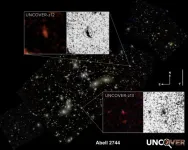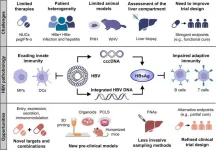(Press-News.org) The second- and fourth-most distant galaxies ever observed have been discovered in a region of space known as Pandora’s Cluster, or Abell 2744, using data from NASA’s James Webb Space Telescope (JWST). Following up on a deep field image of the area, an international team led by Penn State researchers confirmed the distance of these ancient galaxies and inferred their properties using new spectroscopic data — information about light emitted across the electromagnetic spectrum — from JWST. At nearly 33 billion light years away, these incredibly distant galaxies offer insights into how the earliest galaxies might have formed.
Unlike other galaxies confirmed at this distance that appear in images as red dots, the new galaxies are larger and appear like a peanut and a fluffy ball, according to the researchers. A paper describing the galaxies appears today (Nov 13) in the journal Astrophysical Journal Letters.
“Very little is known about the early universe, and the only way to learn about that time and to test our theories of early galaxy formation and growth is with these very distant galaxies,” said first-author Bingjie Wang, postdoctoral scholar in the Penn State Eberly College of Science and a member of the JWST UNCOVER (Ultradeep NIRSpec and NIRCam ObserVations before the Epoch of Reionization) team that conducted the research. “Prior to our analysis, we knew of only three galaxies confirmed at around this extreme distance. Studying these new galaxies and their properties has revealed the diversity of galaxies in the early universe and how much there is to be learned from them.”
Because the light from these galaxies had to travel for so long to reach Earth, it provides a window into the past. The research team estimates that the light detected by JWST was emitted by the two galaxies when the universe was about 330 million years old and traveled for about 13.4 billion light years to reach the JWST. But, the researchers said, the galaxies are currently closer to 33 billion light years away from Earth due to the expansion of the universe over this time.
“The light from these galaxies is ancient, about three times older than the Earth,” said Joel Leja, assistant professor of astronomy and astrophysics at Penn State and a member of UNCOVER. “These early galaxies are like beacons, with light bursting through the very thin hydrogen gas that made up the early universe. It is only by their light that we can begin to understand the exotic physics that governed the galaxy near the cosmic dawn.”
Notably, the two galaxies are considerably larger than the three galaxies previously located at these extreme distances. One is at least six times larger at about 2,000 light years across. For comparison, the Milky Way is approximately 100,000 light years across, but, Wang said, the early universe is thought to have been very compressed, so it’s surprising that the galaxy is as large as it is.
“Previously discovered galaxies at these distances are point sources — they appear as a dot in our images,” Wang said. “But one of ours appears elongated, almost like a peanut, and the other looks like a fluffy ball. It is unclear if the difference in size is due to how the stars formed or what happened to them after they formed, but the diversity in the galaxy properties is really interesting. These early galaxies are expected to have formed out of similar materials, but already they are showing signs of being very different than one another.”
The two galaxies were among 60,000 sources of light in Pandora’s Cluster detected in one of JWST’s first deep field images taken during 2022, its first year of science operations. This region of space was selected in part because it is located behind several galaxy clusters that create a natural magnification effect called gravitational lensing. The gravitational pull of the clusters’ combined mass warps the space around it, focusing and magnifying any light that passes nearby and providing a magnified view behind the clusters.
In a matter of months, the UNCOVER team narrowed down the 60,000 light sources to 700 candidates for follow up study, eight of which they thought could potentially be among the first galaxies. Then, JWST again pointed at Pandora’s Cluster, recording the candidates’ spectra — a sort of fingerprint detailing the amount of light given off at each wavelength.
“Several different teams are using different approaches to look for these ancient galaxies, and each have their strengths and weaknesses,” Leja said. “The fact that we’re pointing at this giant magnifying lens in space gives us an incredibly deep window, but it’s a very small window so we were rolling the dice. Several of the candidates were inconclusive, and at least one was a case of mistaken identity — it was something much closer that mimics a distant galaxy. But we were lucky, and two turned out to be these ancient galaxies. It’s incredible.”
The researchers also used detailed models to infer the properties of these early galaxies when they emitted the light detected by JWST. As the researchers expected, the two galaxies were young, had few metals in their composition, and were growing rapidly and actively forming stars.
“The first elements were forged in the cores of early stars through the process of fusion,” Leja said. “It makes sense that these early galaxies don’t have heavy elements like metals because they were some of the first factories to build those heavy elements. And, of course, they would have to be young and star-forming to be the first galaxies, but confirming these properties is an important basic test of our models and helps confirm the whole paradigm of the Big Bang theory.”
The researchers noted that, alongside the gravitational lens, JWST’s powerful infrared instruments should be able to detect galaxies at an even further distance, if they exist.
“We had a very tiny window into this region, and we didn’t observe anything beyond these two galaxies, even though JWST has the capability,” Leja said. “That could mean that galaxies just didn’t form before that time and that we’re not going to find anything further away. Or it could mean we didn’t get lucky enough with our small window.”
This work was the result of a successful proposal submitted to NASA suggesting how to use JWST during its first year of science operations. In the first three cycles of submissions, NASA received four to ten times more proposals than available observing time on the telescope would allow and had to select only a fraction of those proposals.
“Our team was very excited and a little surprised when our proposal was accepted,” Leja said. “It involved coordination, quick human action and the telescope pointing at the same thing twice, which is a lot to ask of a telescope in its first year. There was a lot of pressure because we only had a few months to determine the objects for follow up. But JWST was built for finding these first galaxies, and it’s so exciting to be doing that now.”
In addition to Penn State, the team includes researchers from the University of Texas Austin, the Swinburne University of Technology in Australia, Ben-Gurion University of the Negev in Israel, Yale University, the University of Pittsburgh, Sorbonne Université in France, the University of Copenhagen in Denmark, the University of Geneva in Switzerland, the University of Massachusetts, the University of Groningen in the Netherlands, Princeton University, Waseda University in Japan, Tufts University and the National Optical-Infrared Astronomy Research (NOIR) Lab.
This work was supported by NASA, the United States-Israel Binational Science Foundation, the U.S. National Science Foundation, the Israel Ministry of Science & Technology, the French National Centre for Space Studies, the French National Institute for Earth Sciences and Astronomy, the Research Corporation for Scientific Advancement, the Dutch Research Council, the European Commission’s and University of Groningen’s CO-FUND Rosalind Franklin program, the National Astronomical Observatory of Japan and the NOIR Lab.
END
Second-most distant galaxy discovered using James Webb Space Telescope
Follow-up observations in Pandora’s cluster confirmed the second- and fourth-most distant galaxies ever seen, which are larger than other galaxies at such extreme distances
2023-11-13
ELSE PRESS RELEASES FROM THIS DATE:
Researchers explore origins of lupus, find reason for condition’s prevalence among women
2023-11-13
For years, researchers and clinicians have known that lupus, an autoimmune condition, occurs in women at a rate nine times higher than in men. Some of the factors that cause the disease’s high prevalence in women have eluded discovery, but in a new study investigating the immune system processes in lupus and the X chromosome, Johns Hopkins Medicine researchers have uncovered answers about the disease’s frequency in females.
A number of dysregulated genetic and biological pathways contribute to the development of lupus and its varied symptoms of muscle and joint pain, ...
Capture or reuse CO2 as a chemical source for the production of sustainable plastics
2023-11-13
A scientific team has developed a new polyurethane production technique using CO2 to create new types of easily recyclable plastics. The study, published in the Journal of the American Chemistry Society (J.A.C.S.), could provide a solution for the development of truly sustainable plastics.
Commodity plastics have transformed global industry. Whether in construction, clothing, vehicles or food packaging, these plastics are everywhere in our daily lives, so much so that their global use has been estimated at around 460 million tons in 2019. This number is staggering, but not surprising, because plastics, also known as synthetic polymers, have met a large ...
Self-deception may seed ‘hubris balancing,’ leading to Putin’s war against Ukraine
2023-11-13
Strategy underlies the affairs of national leaders, including how they view and interact with other states — but what if such strategy is borne of self-deception? That’s the thrust of a novel international relations theory that Ryuta Ito of Hiroshima University has now expanded upon, providing psychological rationalization to explain the irrational acts of national leaders at war.
Ito penned his reasoning on Sept. 5 in the journal International Affairs.
“Why did Vladimir Putin decide to invade Ukraine in 2022?” asked Ito, assistant professor in the Graduate School of Humanities and Social Sciences at Hiroshima University. ...
Appropriate statin prescriptions increase sixfold with automated referrals
2023-11-13
PHILADELPHIA— The odds of prescribing the appropriate dose of statins—a medicine used to lower “bad” cholesterol levels—increased sixfold when automated referrals were made to pharmacy services, instead of relying on traditional prescribing methods, according to researchers at the Perelman School of Medicine at the University of Pennsylvania. More than 90 million people in the U.S. use statins, making it one of the most prescribed medications in the county. Despite their effectiveness in lowering cholesterol levels and the risk of cardiovascular ...
When keeping secrets could brighten your day
2023-11-13
Though people often want to share good news as soon as they learn it, a study published by the American Psychological Association has found that keeping good news a secret before telling someone else could make people feel more energized and alive.
“Decades of research on secrecy suggest it is bad for our well-being, but this work has only examined keeping secrets that have negative implications for our lives. Is secrecy inherently bad for our well-being or do the negative effects of secrecy tend to stem from keeping negative secrets?” asked lead author Michael ...
It takes a village: Hunter-gatherer approach to childcare suggests that the key to mother and child wellbeing may be many caregivers
2023-11-13
Infants and toddlers may be psychologically wired to thrive with high levels of “sensitive care” and personal attention, according to a study conducted with contemporary hunter-gatherer societies.
Research led by an evolutionary anthropologist at Cambridge University found that hunter-gatherer infants receive attentive care and physical contact for about nine hours per day from up to 15 different caregivers.
Dr Nikhil Chaudhary says that, for the vast majority of our species’ evolutionary history, ...
The American Pediatric Society announces its new members for 2023
2023-11-13
The American Pediatric Society (APS) is pleased to announce eighty-four new members. Founded in 1888, the APS is North America's first and most prestigious academic pediatric organization. New members will be recognized during the APS Presidential Plenary at the Pediatric Academic Societies 2024 Meeting.
APS members are recognized child health leaders of extraordinary achievement who work together to shape the future of academic pediatrics. Current members nominate new members by recognizing individuals who have distinguished themselves as child health leaders, ...
Reviewing new challenges and opportunities for hepatitis B cures
2023-11-13
Hepatitis B virus (HBV) is a significant public health problem, with over 296 million people chronically infected worldwide. Despite the availability of a safe and effective vaccine for over 40 years, HBV remains a leading cause of liver disease and death.
One of the main challenges to curing HBV is the unique biology of the virus. HBV replicates through a covalently closed circular DNA (cccDNA) intermediate integrated into the host genome. This makes it very difficult to eradicate the virus completely, even with effective antiviral therapy. Another challenge is the impaired immune response to HBV in chronically infected individuals. The virus has evolved several mechanisms to evade ...
AI faces look more real than actual human face
2023-11-13
White faces generated by artificial intelligence (AI) now appear more real than human faces, according to new research led by experts at The Australian National University (ANU).
In the study, more people thought AI-generated white faces were human than the faces of real people. The same wasn’t true for images of people of colour.
The reason for the discrepancy is that AI algorithms are trained disproportionately on white faces, Dr Amy Dawel, the senior author of the paper, said.
“If white AI faces are consistently perceived as more realistic, this technology could have serious implications for people of colour by ultimately reinforcing ...
Forming ice: There’s a fungal protein for that
2023-11-13
The way ice forms is a lot more interesting than you think. This basic physical process, among the most common in nature, also remains somewhat mysterious despite decades of scientific scrutiny.
Now new research from the University of Utah, with Germany’s Max Plank Institute for Polymer Research and Idaho’s Boise State University, is shedding fresh light on the role of biological agents—produced by fungi of all things—in ice formation.
Contrary to what we have been taught in school, water won’t necessarily freeze at 0 degrees Celsius (32 degrees F) because of the energy barrier ...
LAST 30 PRESS RELEASES:
Safety decision-making for autonomous vehicles integrating passenger physiological states by fNIRS
Fires could emit more air pollution than previously estimated
A new way to map how cells choose their fate
Numbers in our sights affect how we perceive space
SIMJ announces global collaborative book project in commemoration of its 75th anniversary
Air pollution exposure and birth weight
Obstructive sleep apnea risk and mental health conditions among older adults
How talking slows eye movements behind the wheel
The Ceramic Society of Japan’s Oxoate Ceramics Research Association launches new international book project
Heart-brain connection: international study reveals the role of the vagus nerve in keeping the heart young
Researchers identify Rb1 as a predictive biomarker for a new therapeutic strategy in some breast cancers
Survey reveals ethical gaps slowing AI adoption in pediatric surgery
Stimulant ADHD medications work differently than thought
AI overestimates how smart people are, according to HSE economists
HSE researchers create genome-wide map of quadruplexes
Scientists boost cell "powerhouses" to burn more calories
Automatic label checking: The missing step in making reliable medical AI
Low daily alcohol intake linked to 50% heightened mouth cancer risk in India
American Meteorological Society announces Rick Spinrad as 2026 President-Elect
Biomass-based carbon capture spotlighted in newly released global climate webinar recording
Illuminating invisible nano pollutants: advanced bioimaging tracks the full journey of emerging nanoscale contaminants in living systems
How does age affect recovery from spinal cord injury?
Novel AI tool offers prognosis for patients with head and neck cancer
Fathers’ microplastic exposure tied to their children’s metabolic problems
Research validates laboratory model for studying high-grade serous ovarian cancer
SIR 2026 delivers transformative breakthroughs in minimally invasive medicine to improve patient care
Stem Cell Reports most downloaded papers of 2025 highlight the breadth and impact of stem cell research
Oxford-led study estimates NHS spends around 3% of its primary and secondary care budget on the health impacts of heat and cold in England
A researcher’s long quest leads to a smart composite breakthrough
Urban wild bees act as “microbial sensors” of city health.
[Press-News.org] Second-most distant galaxy discovered using James Webb Space TelescopeFollow-up observations in Pandora’s cluster confirmed the second- and fourth-most distant galaxies ever seen, which are larger than other galaxies at such extreme distances



